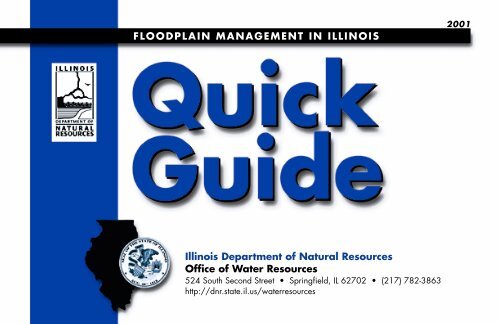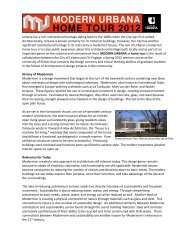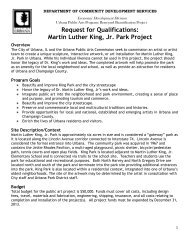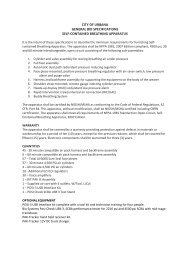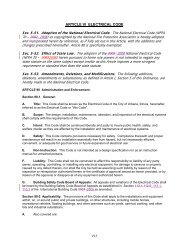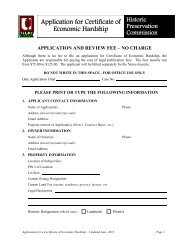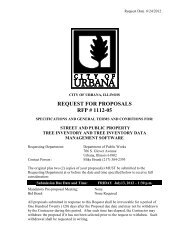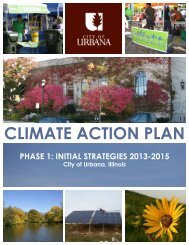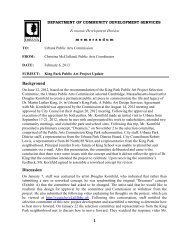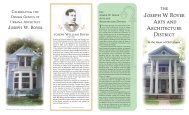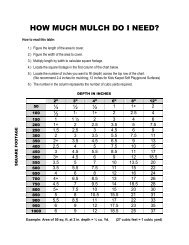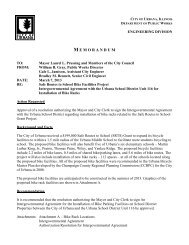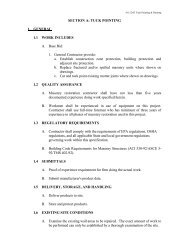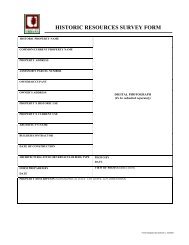Floodplain Management in Illinois - Illinois Department of Natural ...
Floodplain Management in Illinois - Illinois Department of Natural ...
Floodplain Management in Illinois - Illinois Department of Natural ...
You also want an ePaper? Increase the reach of your titles
YUMPU automatically turns print PDFs into web optimized ePapers that Google loves.
FLOODPLAIN MANAGEMENT IN ILLINOIS<br />
2001<br />
Ill<strong>in</strong>ois <strong>Department</strong> <strong>of</strong> <strong>Natural</strong> Resources<br />
Office <strong>of</strong> Water Resources<br />
524 South Second Street • Spr<strong>in</strong>gfield, IL 62702 • (217) 782-3863<br />
http://dnr.state.il.us/waterresources
Table <strong>of</strong> Contents<br />
1 ........... About This Guide<br />
2 ........... Why do we Regulate the <strong>Floodpla<strong>in</strong></strong><br />
3 ........... Community Responsibilities<br />
4 ........... Understand<strong>in</strong>g the River<strong>in</strong>e <strong>Floodpla<strong>in</strong></strong><br />
5 ........... Understand<strong>in</strong>g the Floodway<br />
6 ........... The Countywide Flood Insurance Rate Map<br />
7 ........... The Flood Insurance Rate Map<br />
8 ........... Use the Flood Pr<strong>of</strong>ile to Determ<strong>in</strong>e BFEs<br />
9 ........... Approximate Flood Zones<br />
10 ......... Flood Map Revisions<br />
11 ......... <strong>Floodpla<strong>in</strong></strong> Development Includes<br />
12 ......... Safe Uses <strong>of</strong> the <strong>Floodpla<strong>in</strong></strong><br />
13 ......... What is the Elevation Certificate and How is it Used<br />
14 ......... Complet<strong>in</strong>g the Elevation Certificate<br />
15 ......... Is Your Land Higher than the BFE<br />
16 ......... What is Meant by “Pre-FIRM” and “Post-FIRM”<br />
17 ......... Nature Doesn’t Read Maps<br />
18 ......... Go the Extra Foot!<br />
19 ......... Some Key Permit Review Steps<br />
20 ......... Carefully Complete the Permit Application<br />
21 ......... Floodway Development Proposals<br />
22 ......... <strong>Floodpla<strong>in</strong></strong> Fill Can Make Th<strong>in</strong>gs Worse<br />
23 ......... How to Elevate Your <strong>Floodpla<strong>in</strong></strong> Build<strong>in</strong>g<br />
24 ......... A Basement is Not a Good Idea<br />
25 ......... Manufactured Homes Deserve Special Attention<br />
26 ......... Enclosures Below BFE<br />
27 ......... Utility Service for Build<strong>in</strong>gs<br />
28 ......... Accessory Structures<br />
29 ......... Recreational Vehicles<br />
30 ......... Agricultural Structures<br />
31 ......... Plann<strong>in</strong>g to Improve Your <strong>Floodpla<strong>in</strong></strong> Build<strong>in</strong>g<br />
32 ......... What About After Damages<br />
33 ......... Elevat<strong>in</strong>g a Pre-FIRM Build<strong>in</strong>g<br />
34 ......... Th<strong>in</strong>k Carefully About Variances<br />
35 ......... Paperwork is Important – for You and Your Community<br />
36 ......... Some Flood Protection for Older Homes is Easy and Low Cost<br />
37 ......... Some Flood Mitigation Projects are More Costly<br />
38 ......... Want to Learn More<br />
ILLINOIS QUICK GUIDE
About This Guide<br />
The <strong>Floodpla<strong>in</strong></strong> <strong>Management</strong> Quick Guide was orig<strong>in</strong>ally prepared by<br />
our friends and neighbors at the Missouri State Emergency <strong>Management</strong><br />
Agency. The State <strong>of</strong> Missouri has graciously allowed it to be edited<br />
and modified for use <strong>in</strong> Ill<strong>in</strong>ois. Copyright laws do not apply.<br />
The development <strong>of</strong> this Quick Guide was supported by fund<strong>in</strong>g from<br />
our partners at the Federal Emergency <strong>Management</strong> Agency (FEMA).<br />
The contents may not necessarily reflect the views and policies <strong>of</strong> the<br />
Federal government.<br />
Questions and comments can be directed to the Ill<strong>in</strong>ois <strong>Department</strong><br />
<strong>of</strong> <strong>Natural</strong> Resources/Office <strong>of</strong> Water Resources (IDNR/OWR) at<br />
(217) 782-3862. We encourage any comments and suggestions for<br />
improvements to this Guide. For additional copies, please call<br />
IDNR/OWR.<br />
The Ill<strong>in</strong>ois <strong>Floodpla<strong>in</strong></strong> <strong>Management</strong>: Local <strong>Floodpla<strong>in</strong></strong> Adm<strong>in</strong>istrator’s Manual and other publications on<br />
floodpla<strong>in</strong> management are available from IDNR, and other documents are available from FEMA.<br />
Please contact us if you have questions or need further assistance.<br />
1<br />
ILLINOIS QUICK GUIDE
Why Do We Regulate the <strong>Floodpla<strong>in</strong></strong><br />
To protect people and property. <strong>Floodpla<strong>in</strong></strong> management is about build<strong>in</strong>g smart. It makes good sense. If we<br />
know part <strong>of</strong> our land will flood from time to time, shouldn’t we make reasonable decisions to help protect our<br />
families, homes, and bus<strong>in</strong>esses<br />
To make sure that federal flood <strong>in</strong>surance and disaster assistance are available. If your home or<br />
bus<strong>in</strong>ess is <strong>in</strong> the floodpla<strong>in</strong>, and federal flood <strong>in</strong>surance isn’t available, then you can’t get some types <strong>of</strong> federal<br />
f<strong>in</strong>ancial assistance. Mortgages will be hard to f<strong>in</strong>d, and you won’t be able to get some types <strong>of</strong> state and federal<br />
loans and grants.<br />
To save tax dollars. Every flood disaster affects the town’s budget. If we build smarter, we’ll have fewer<br />
problems the next time the river rises. Remember, federal disaster assistance doesn’t kick <strong>in</strong> for all floods. And<br />
even when the President declares a disaster, your community still has to pay a lot to cover the costs <strong>of</strong> evacuation,<br />
temporary hous<strong>in</strong>g, repair, and clean-up.<br />
To avoid liability and law suits. If we know an area is mapped as floodpla<strong>in</strong> and likely to flood — if we know<br />
people could be <strong>in</strong> danger — if we know that build<strong>in</strong>gs could be damaged, doesn’t it make sense to take<br />
reasonable protective steps when we develop and build<br />
To reduce future flood losses <strong>in</strong> Ill<strong>in</strong>ois. The laws <strong>in</strong> Ill<strong>in</strong>ois are simply a “good neighbor” policy designed to<br />
protect our citizens from future flood losses. It is illegal to do any floodway activity that may <strong>in</strong>crease or divert<br />
flood waters onto neighbor<strong>in</strong>g properties. These laws help keep flood<strong>in</strong>g conditions from gett<strong>in</strong>g worse as more<br />
and more development takes place.<br />
2<br />
ILLINOIS QUICK GUIDE
Community Responsibilities<br />
To participate <strong>in</strong> the National Flood Insurance Program, your community agrees to:<br />
Adopt and enforce a <strong>Floodpla<strong>in</strong></strong> management ord<strong>in</strong>ance<br />
Require permits for all types <strong>of</strong> development <strong>in</strong> the <strong>Floodpla<strong>in</strong></strong> (see page 11)<br />
Assure that build<strong>in</strong>g sites are reasonably safe from flood<strong>in</strong>g<br />
Require new or improved homes and manufactured homes to be<br />
elevated above the Base Flood Elevation (BFE)<br />
Require other build<strong>in</strong>gs to be elevated or floodpro<strong>of</strong>ed<br />
Conduct field <strong>in</strong>spections and cite violations<br />
Require Elevation Certificates to document compliance (see pages 13 and 14)<br />
Carefully consider requests for variances<br />
Advise FEMA when updates to Flood maps are needed<br />
3<br />
ILLINOIS QUICK GUIDE
Understand<strong>in</strong>g the River<strong>in</strong>e <strong>Floodpla<strong>in</strong></strong><br />
Fr<strong>in</strong>ge<br />
<strong>Floodpla<strong>in</strong></strong><br />
Floodway<br />
Stream<br />
Channel<br />
Fr<strong>in</strong>ge<br />
Terms and<br />
Def<strong>in</strong>itions<br />
The <strong>Floodpla<strong>in</strong></strong> is the land that is<br />
subject to a 1%-annual-chance<br />
or greater chance <strong>of</strong> flood<strong>in</strong>g <strong>in</strong><br />
any given year. On FIRMs and<br />
Floodway maps, the <strong>Floodpla<strong>in</strong></strong><br />
may be designated as Zones A,<br />
AO, AH, A1-30, AE, or A99.<br />
See page 5, Understand<strong>in</strong>g the<br />
Floodway, to learn about the<br />
area <strong>of</strong> the floodpla<strong>in</strong> where<br />
floodwaters usually flow faster<br />
and deeper.<br />
For <strong>Floodpla<strong>in</strong></strong>s with Base Flood Elevations, check the Flood Insurance Study to f<strong>in</strong>d the Flood Pr<strong>of</strong>ile which shows<br />
water surface elevations for different frequency floods ( see page 8).<br />
4<br />
ILLINOIS QUICK GUIDE
Understand<strong>in</strong>g the Floodway<br />
A<br />
Flood<br />
Fr<strong>in</strong>ge<br />
Simulated<br />
Encroachment<br />
*Surcharge not to exceed 0.1 foot [Ill<strong>in</strong>ois requirement]<br />
C<br />
Area <strong>of</strong> floodpla<strong>in</strong> that could be<br />
used for development by rais<strong>in</strong>g ground<br />
L<strong>in</strong>e<br />
L<strong>in</strong>e<br />
A<br />
C<br />
<strong>Floodpla<strong>in</strong></strong><br />
B<br />
D<br />
Floodway<br />
Stream<br />
Channel<br />
Surcharge*<br />
D<br />
Flood<br />
Fr<strong>in</strong>ge<br />
Simulated<br />
Encroachment<br />
= Flood Elevation Before Encroachment<br />
= Flood Elevation After Encroachment<br />
B<br />
Flood elevation before<br />
encroachment<br />
Simulated Encroachment<br />
Terms and<br />
Def<strong>in</strong>itions<br />
The Floodway is the channel <strong>of</strong> a river<br />
or other watercourse and the adjacent<br />
land areas that must be reserved <strong>in</strong><br />
order to pass the base flood without<br />
<strong>in</strong>creas<strong>in</strong>g the water surface elevation<br />
more than a designated height.<br />
Computer models <strong>of</strong> the floodpla<strong>in</strong><br />
are used to simulate “encroachment”<br />
or fill <strong>in</strong> the flood fr<strong>in</strong>ge <strong>in</strong> order to<br />
predict where and how much the<br />
base flood elevation would <strong>in</strong>crease if<br />
the floodpla<strong>in</strong> is allowed to be filled.<br />
In Ill<strong>in</strong>ois, the Floodway boundary is<br />
drawn where the computer model<br />
<strong>in</strong>dicates that the water surface will<br />
<strong>in</strong>crease 0.1' due to the simulated<br />
encroachment.<br />
For Floodway proposals, before a local floodpla<strong>in</strong> permit can be issued a State <strong>of</strong> Ill<strong>in</strong>ois Permit<br />
must be obta<strong>in</strong>ed. You may need a qualified eng<strong>in</strong>eer to make sure your<br />
proposed project won’t <strong>in</strong>crease flood<strong>in</strong>g on others.<br />
5<br />
ILLINOIS QUICK GUIDE
The Countywide Flood Insurance Rate Map<br />
Newer FIRMs comb<strong>in</strong>e counties and<br />
<strong>in</strong>corporated municipalities, so match<strong>in</strong>g<br />
across boundaries isn’t a problem.<br />
The Floodway is the ”cross-hatched”<br />
area<br />
ZONE AE is the 100-year<br />
(1%-annual-chance) floodpla<strong>in</strong><br />
ZONE X (shaded) shows areas<br />
affected by the 500-year flood<br />
(formerly B Zone)<br />
1<br />
2<br />
3<br />
ZONE X (unshaded) is all other areas<br />
(formerly C Zone)<br />
4<br />
The Floodway is the area where most conveyance and velocity flows occur.<br />
In Ill<strong>in</strong>ois, very specific laws govern the use <strong>of</strong> Floodways (see page 5).<br />
6<br />
ILLINOIS QUICK GUIDE
The Flood Insurance Rate Map<br />
NOTE:<br />
This FIRM does not<br />
show a floodway<br />
(see page 6).<br />
1<br />
2<br />
3<br />
4<br />
5<br />
BASE FLOOD ELEVATION (BFE).<br />
Water surface elevation (<strong>in</strong> feet above datum) <strong>of</strong><br />
the base flood at specific locations (cross-sections).<br />
ELEVATION REFERENCE MARKS (RM).<br />
Po<strong>in</strong>ts for which ground elevation data have been<br />
established and recorded on the FIRM or <strong>in</strong> the<br />
Flood Insurance Study.<br />
FLOOD HAZARD ZONES.<br />
Zone A, Zones A1-A30, and Zone AE are<br />
subject to flood<strong>in</strong>g by the base or 100-year flood<br />
(1% annual chance).<br />
Zone B is subject to flood<strong>in</strong>g by the 500-year<br />
flood (0.2% annual chance).<br />
Zone C is all other areas.<br />
FEMA prepares Flood Insurance Rate Maps to show<br />
areas that are predicted to flood after <strong>in</strong>tense or<br />
major storms. The FIRMs estimate how high the water<br />
may rise, called the Base Flood Elevation.<br />
7<br />
ILLINOIS QUICK GUIDE
Use the Flood Pr<strong>of</strong>ile to Determ<strong>in</strong>e BFEs<br />
1<br />
Road<br />
Flood pr<strong>of</strong>iles can be used<br />
to determ<strong>in</strong>e the BFE at a<br />
specific site. Pr<strong>of</strong>iles also<br />
show predicted water<br />
surface elevations for floods<br />
other than the 100-year<br />
flood.<br />
2 1<br />
On the Flood Insurance<br />
Rate Map, locate your site<br />
by measur<strong>in</strong>g the distance,<br />
along the stream channel,<br />
from a cross section,<br />
for example, or .<br />
1<br />
2<br />
Scale that distance on the<br />
Flood Pr<strong>of</strong>ile and read up<br />
to the pr<strong>of</strong>ile <strong>of</strong> <strong>in</strong>terest,<br />
then across to determ<strong>in</strong>e<br />
the elevation.<br />
8<br />
ILLINOIS QUICK GUIDE
Approximate Flood Zones<br />
Approximate flood zones are<br />
drawn based on exist<strong>in</strong>g<br />
<strong>in</strong>formation, not eng<strong>in</strong>eer<strong>in</strong>g<br />
studies. FEMA checked with the<br />
U.S. Army Corps <strong>of</strong> Eng<strong>in</strong>eers, the<br />
U.S. Geological Survey, the State,<br />
local <strong>of</strong>ficials, and sources <strong>of</strong><br />
historic records. When exist<strong>in</strong>g<br />
<strong>in</strong>formation was lack<strong>in</strong>g, an<br />
approximation analysis was<br />
performed.<br />
Topographic maps can be used to estimate the Base Flood Elevation.<br />
If you need help determ<strong>in</strong><strong>in</strong>g the<br />
BFE, check with your community<br />
permit <strong>of</strong>fice, FEMA or IDNR/<br />
OWR. FEMA publication<br />
Manag<strong>in</strong>g <strong>Floodpla<strong>in</strong></strong><br />
Development <strong>in</strong> Approximate<br />
Zone A Areas (FEMA 265) is<br />
useful for eng<strong>in</strong>eers. The Ill<strong>in</strong>ois<br />
State Water Survey may be able<br />
to determ<strong>in</strong>e a BFE for a<br />
m<strong>in</strong>imal fee, (217) 333-0447.<br />
9<br />
ILLINOIS QUICK GUIDE
Flood Map Revisions<br />
There Are Three Primary Types <strong>of</strong> Flood Map Revisions<br />
1.<br />
2.<br />
Letter <strong>of</strong> Map Amendment (LOMA) – issued when a property owner<br />
demonstrates that the natural ground is higher than the BFE (see page 15).<br />
Lenders may waive the flood <strong>in</strong>surance requirement if the LOMA documents<br />
that a home is not <strong>in</strong> the mapped floodpla<strong>in</strong>.<br />
Letter <strong>of</strong> Map Revision Based on Fill (LOMR-F) – issued when fill has been<br />
placed to raise the land above the BFE. For multiple lots, the applicant must<br />
certify compaction <strong>of</strong> the fill. Lenders can waive the <strong>in</strong>surance requirement if<br />
the LOMR-F demonstrates that homes on fill are above the BFE.<br />
Important<br />
Information<br />
Check FEMA’s Flood<br />
Hazard Mapp<strong>in</strong>g Web<br />
Site for more<br />
<strong>in</strong>formation about map<br />
revisions concern<strong>in</strong>g<br />
Homeowners<br />
3.<br />
Physical Map Revision (LOMR PMR) – issued for floodpla<strong>in</strong> changes that<br />
require eng<strong>in</strong>eer<strong>in</strong>g analyses, such as bridges, culverts, channel changes,<br />
flood control measures, and large fills that change the BFE or Floodway.<br />
Physical map revisions are also issued when a new study updates or<br />
improves the FIRM.<br />
and<br />
Eng<strong>in</strong>eers/Surveyors.<br />
www.fema.gov/mit/tsd<br />
10<br />
ILLINOIS QUICK GUIDE
<strong>Floodpla<strong>in</strong></strong> Development Includes:<br />
Construction <strong>of</strong> new build<strong>in</strong>gs<br />
Additions to exist<strong>in</strong>g build<strong>in</strong>gs<br />
Substantial improvement <strong>of</strong> exist<strong>in</strong>g build<strong>in</strong>gs<br />
Placement <strong>of</strong> manufactured (mobile) homes<br />
Subdivision <strong>of</strong> land<br />
Temporary build<strong>in</strong>gs and accessory structures.<br />
Agricultural build<strong>in</strong>gs<br />
Recreational vehicles<br />
Storage <strong>of</strong> materials, <strong>in</strong>clud<strong>in</strong>g gas/liquid tanks<br />
Roads, bridges, and culverts<br />
Fill, grad<strong>in</strong>g, excavation, m<strong>in</strong><strong>in</strong>g, and dredg<strong>in</strong>g<br />
Alter<strong>in</strong>g stream channels<br />
YOU NEED PERMITS FOR ALL OF THESE ACTIVITIES.<br />
11<br />
ILLINOIS QUICK GUIDE
Safe Uses <strong>of</strong> the <strong>Floodpla<strong>in</strong></strong><br />
All land subdivided <strong>in</strong>to lots, some lots<br />
partially <strong>in</strong> the <strong>Floodpla<strong>in</strong></strong>, setbacks<br />
modified to keep homesites on high ground.<br />
RECOMMENDED<br />
All land subdivided <strong>in</strong>to lots, some<br />
homesites and lots partially or<br />
entirely <strong>in</strong> the <strong>Floodpla<strong>in</strong></strong>.<br />
NOT RECOMMENDED<br />
<strong>Floodpla<strong>in</strong></strong> land put <strong>in</strong>to public/<br />
common open space, net density<br />
rema<strong>in</strong>s, lot sizes reduced and<br />
setbacks modified to keep<br />
homesites on high ground.<br />
RECOMMENDED<br />
If possible, keep it natural open space – let the floodpla<strong>in</strong> do its job. Other low damage uses: recreational areas,<br />
playgrounds, reforestation, park<strong>in</strong>g, gardens, pasture, accessory structures, created wetlands.<br />
12<br />
ILLINOIS QUICK GUIDE
What is the Elevation Certificate and How is it Used<br />
The Elevation Certificate (EC) is a FEMA form.<br />
The EC must be completed by a registered surveyor or eng<strong>in</strong>eer when the<br />
floodpla<strong>in</strong> has BFEs.<br />
A community <strong>of</strong>ficial may complete the EC for sites <strong>in</strong> approximate flood zones.<br />
It can be used to show that sites are natural ground above the base flood<br />
elevation (see page 15).<br />
It is used to verify that build<strong>in</strong>gs are elevated properly (see page 20).<br />
Insurance agents use the EC to write flood <strong>in</strong>surance policies (see page 35).<br />
By itself, the EC cannot be used to waive the requirement to get flood<br />
<strong>in</strong>surance. See page 10 to learn about Letters <strong>of</strong> Map Amendment.<br />
13<br />
ILLINOIS QUICK GUIDE
Complet<strong>in</strong>g the Elevation Certificate<br />
Elevation Certificate (partial)<br />
RM166<br />
In this example, the BFE is 485.<br />
486 0<br />
n/a<br />
n/a<br />
482 5<br />
486 0<br />
482 5<br />
486 0<br />
three<br />
386<br />
(g)<br />
x<br />
(a)<br />
(e)<br />
ATTACHED GARAGE<br />
ELECTRICAL BOX<br />
WIRED FROM<br />
CEILING<br />
BFE<br />
The slab-on-grade house was elevated<br />
on fill 1’ above the BFE, and the<br />
vented garage is 2.5’ below the BFE<br />
COMPACTED FILL<br />
FLOOD OPENING<br />
HOT WATER HEATER<br />
ELEVATED ON A<br />
PLATFORM<br />
(f)<br />
(d)<br />
You will get a blank Elevation Certificate form when you get your permit. You must have a surveyor or eng<strong>in</strong>eer fill it out<br />
and seal it. The Elevation Certificate <strong>in</strong>cludes diagrams for eight build<strong>in</strong>gs types. Several po<strong>in</strong>ts must be surveyed.<br />
14<br />
ILLINOIS QUICK GUIDE
Is Your Land Higher than the BFE<br />
Sealed Signature<br />
ELEVATION<br />
CERTIFICATE<br />
Lowest Adjacent<br />
Grade Higher<br />
Than BFE<br />
LOMA<br />
LOWEST<br />
ADJACENT GRADE<br />
Your Lot IS<br />
Above The BFE…<br />
Not Required<br />
To Buy<br />
Flood Insurance<br />
BFE<br />
If your land is shown on the map as “<strong>in</strong>” the <strong>Floodpla<strong>in</strong></strong>, but your build<strong>in</strong>g site is higher than the BFE…<br />
get a surveyor to fill <strong>in</strong> the FEMA Elevation Certificate. FEMA may issue a Letter <strong>of</strong> Map Amendment.<br />
This is the ONLY way to remove the requirement to buy flood <strong>in</strong>surance.<br />
Keep the EC with your deed, it will help future buyers.<br />
15<br />
ILLINOIS QUICK GUIDE
What is Meant by Pre-FIRM and Post-FIRM<br />
Pre-FIRM<br />
(Older Build<strong>in</strong>gs<br />
usually are not elevated)<br />
FIRST FLOOR<br />
AND LOWEST FLOOR<br />
BFE<br />
Post-FIRM<br />
(Newer build<strong>in</strong>gs are elevated)<br />
FIRST FLOOR<br />
AND LOWEST FLOOR<br />
A build<strong>in</strong>g is Pre-FIRM if it was built before your community adopted the flood ord<strong>in</strong>ance<br />
and Flood Insurance Rate Map.<br />
If is was built after adoption, it is Post-FIRM.<br />
Improvements or repairs to Pre-FIRM build<strong>in</strong>gs may require permits (see pages 31 and 32).<br />
16<br />
ILLINOIS QUICK GUIDE
Nature Doesn’t Read Maps<br />
Important<br />
Information<br />
500-year<br />
elevation<br />
100-year<br />
elevation<br />
10-year<br />
elevation<br />
Many people don’t<br />
understand just how<br />
risky the floodpla<strong>in</strong><br />
can be. There is a<br />
26% chance that a<br />
home <strong>in</strong> the <strong>Floodpla<strong>in</strong></strong><br />
will flood dur<strong>in</strong>g a<br />
30-year mortgage<br />
period. The chance<br />
that a major fire will<br />
occur dur<strong>in</strong>g the same<br />
period is only 1%!<br />
CAUTION! Nature doesn’t read the flood map! Rare major storms cause flood<strong>in</strong>g that rises higher than the BFE.<br />
Consider safety – protect your home or bus<strong>in</strong>ess by build<strong>in</strong>g higher.<br />
See page 18 to see how this will save you money on <strong>in</strong>surance.<br />
17<br />
ILLINOIS QUICK GUIDE
Go the Extra Foot!<br />
Want to save some money and have peace <strong>of</strong> m<strong>in</strong>d at the same time<br />
Then build higher than the m<strong>in</strong>imum elevation requirement!<br />
Lowest Floor Relative to BFE<br />
18<br />
+2<br />
+1<br />
BFE<br />
–1<br />
–2<br />
B<br />
$1,000<br />
House A on vented crawlspace<br />
Post-FIRM <strong>in</strong> AE Zone with BFE<br />
$100,000 <strong>in</strong>surance on the build<strong>in</strong>g<br />
$40,000 <strong>in</strong>surance on contents<br />
House B MFH on re<strong>in</strong>forced pil<strong>in</strong>gs<br />
Post-FIRM <strong>in</strong> A Zone with BFE<br />
$40,000 <strong>in</strong>surance on unit<br />
$20,000 <strong>in</strong>surance on contents<br />
A<br />
Annual Flood Insurance Cost<br />
$2,000 $3,000<br />
SUBMIT TO<br />
FEMA IF<br />
2 OR MORE<br />
FEET BELOW<br />
BFE<br />
Important<br />
Information<br />
NOTE: Flood <strong>in</strong>surance<br />
rates and various fees<br />
change from time to time.<br />
Rather than specific costs for<br />
<strong>in</strong>surance, this figure gives a<br />
feel for how much difference<br />
just a foot or two can make.<br />
Build<strong>in</strong>g owners will save<br />
<strong>in</strong>surance money if they<br />
elevate above the BFE. But<br />
more impressive is how the<br />
cost <strong>of</strong> <strong>in</strong>surance nearly<br />
doubles if the build<strong>in</strong>g is<br />
only one foot below the BFE.<br />
Remember! The community<br />
may be able to grant a<br />
variance, but the owner may<br />
still have to buy <strong>in</strong>surance.<br />
Imag<strong>in</strong>e try<strong>in</strong>g to sell a<br />
house if the bank requires<br />
<strong>in</strong>surance that costs over<br />
$2,000 a year!<br />
ILLINOIS QUICK GUIDE
Some Key Permit Review Steps<br />
The Permit Reviewer has to Check Many Th<strong>in</strong>gs.<br />
Some <strong>of</strong> the Key Questions are:<br />
Is the site <strong>in</strong> the mapped <strong>Floodpla<strong>in</strong></strong><br />
Is the site <strong>in</strong> the mapped Floodway<br />
Has an IDNR/OWR permit been obta<strong>in</strong>ed<br />
Have other State and Federal permits been obta<strong>in</strong>ed<br />
Does the site plan show the Base Flood Elevation<br />
Review Checklist<br />
<strong>Floodpla<strong>in</strong></strong><br />
Floodway<br />
BFE<br />
New Construction<br />
Elevated<br />
Is improvement <strong>of</strong> an older build<strong>in</strong>g proposed<br />
Will new build<strong>in</strong>gs and utilities be elevated properly<br />
Elevation Certificiate<br />
Issue Permit<br />
Will manufactured homes be properly elevated and anchored<br />
Has the owner submitted an Elevation Certificate<br />
19<br />
ILLINOIS QUICK GUIDE
Carefully Complete the Permit Application<br />
Good <strong>in</strong>formation will lead to better construction and less exposure to future flood damage.<br />
20<br />
ILLINOIS QUICK GUIDE
Floodway Development Proposals<br />
For Floodway proposals, before a local<br />
floodpla<strong>in</strong> permit can be issued a State <strong>of</strong><br />
Ill<strong>in</strong>ois Jo<strong>in</strong>t Permit must be obta<strong>in</strong>ed.<br />
You may need a qualified eng<strong>in</strong>eer to make<br />
sure your proposed project won’t <strong>in</strong>crease<br />
flood<strong>in</strong>g on others.<br />
Important<br />
Information<br />
In the six-county area<br />
around Chicago,<br />
only specific openspace<br />
or water<br />
dependent<br />
appropriate uses are<br />
allowed <strong>in</strong> the<br />
Floodway. Be sure to<br />
contact IDNR/OWR<br />
before ANY<br />
Floodway<br />
development.<br />
21<br />
ILLINOIS QUICK GUIDE
<strong>Floodpla<strong>in</strong></strong> Fill Can Make Th<strong>in</strong>gs Worse<br />
<strong>Floodpla<strong>in</strong></strong>s are supposed to store floodwater. If storage space is filled with dirt and other fill,<br />
future flood<strong>in</strong>g may be worsened. Your community may require an eng<strong>in</strong>eer<strong>in</strong>g analysis<br />
to show how floodpla<strong>in</strong> fill will alter flood<strong>in</strong>g.<br />
<strong>Natural</strong> <strong>Floodpla<strong>in</strong></strong><br />
FILL<br />
Obstructed With Fill<br />
Make sure your floodpla<strong>in</strong> fill project won’t harm your neighbors.<br />
In Ill<strong>in</strong>ois, very specific laws govern the use <strong>of</strong> Floodways (see page 5 and 21).<br />
22<br />
ILLINOIS QUICK GUIDE
How to Elevate Your <strong>Floodpla<strong>in</strong></strong> Build<strong>in</strong>g<br />
Elevate on Foundation Walls<br />
Elevate on Fill<br />
SERVICE<br />
EQUIPMENT<br />
SUCH AS UTILITIES AND<br />
ELECTRICAL CIRCUITS,<br />
ABOVE FLOOD<br />
LEVEL<br />
ENCLOSED AREA<br />
USED ONLY FOR<br />
PARKING, ACCESS,<br />
OR LIMITED STORAGE<br />
SERVICE<br />
EQUIPMENT<br />
SUCH AS UTILITIES<br />
AND ELECTRICAL<br />
CIRCUITS<br />
OPENINGS ON<br />
EACH WALL ENSURE<br />
ENTRY OF WATER TO<br />
EQUALIZE HYDROSTATIC<br />
PRESSURE<br />
BFE<br />
2<br />
1<br />
COMPACTED FILL<br />
AT LEAST 10'–15' BEYOND HOUSE<br />
CAUTION! Crawlspaces and other enclosures have some special requirements, see page 26.<br />
Note: When a build<strong>in</strong>g is at the m<strong>in</strong>imum elevation, under-floor utilities are not allowed.<br />
23<br />
ILLINOIS QUICK GUIDE
A Basement is NOT a Good Idea<br />
FIRST FLOOR<br />
DOOR<br />
FIRST FLOOR<br />
DOOR<br />
GROUND<br />
LIVING AREA<br />
BASEMENT WINDOW<br />
LIVING AREA<br />
FILL LEVEL<br />
SUBGRADE<br />
BASEMENT<br />
Terms and<br />
Def<strong>in</strong>itions<br />
A basement is any<br />
area that is below<br />
grade on all sides. A<br />
crawl space is a<br />
basement if the <strong>in</strong>terior<br />
grade is lower than the<br />
exterior grade.<br />
SATURATED FILL<br />
Basements are not allowed <strong>in</strong> new development and flood <strong>in</strong>surance coverage is very<br />
limited <strong>in</strong> exist<strong>in</strong>g basements for a very good reason. It only takes an <strong>in</strong>ch <strong>of</strong> water over<br />
the sill and the entire basement fills up! Excavat<strong>in</strong>g a basement <strong>in</strong>to fill doesn’t always<br />
make it safe because saturated ground water can damage the walls.<br />
24<br />
ILLINOIS QUICK GUIDE
Manufactured Homes Deserve Special Attention<br />
OVER-THE-TOP<br />
FRAME STRAP<br />
ELEVATED<br />
UTILITY<br />
PLATFORM<br />
Experience shows that manufactured<br />
homes are easily damaged. As little<br />
as one foot <strong>of</strong> water can cause<br />
substantial damage.<br />
Dry stacked blocks are not<br />
acceptable — they will NOT<br />
withstand a flood.<br />
BFE<br />
GROUND<br />
CONCRETE<br />
FILLED<br />
CINDERBLOCK<br />
HELICAL GROUND ANCHORS<br />
#5 DOWELS<br />
Manufactured homes must be anchored to resist flotation, collapse, or lateral<br />
movement by be<strong>in</strong>g tied down <strong>in</strong> accordance with the Rules and Regulations<br />
for the Ill<strong>in</strong>ois Mobile Home Tie-Down Act<br />
(77 IL Adm<strong>in</strong>istrative Code 870, IL Dept. <strong>of</strong> Public Health).<br />
3- #4 REINF.<br />
EACH WAY<br />
CONCRETE<br />
FOOTER<br />
BELOW<br />
FROST LINE<br />
8"<br />
MIN.<br />
25<br />
ILLINOIS QUICK GUIDE
Enclosures Below the BFE<br />
NOTE:<br />
TOTAL OPENING AREA IS 1 SQ. IN.<br />
PER SQ. FT. A 25' X 45' BUILDING<br />
NEEDS 1125 SQ. INCHES OF<br />
OPENINGS<br />
LOWEST<br />
FLOOR<br />
BFE<br />
INTERIOR GROUND<br />
LEVEL AT OR<br />
ABOVE<br />
OUTSIDE GRADE<br />
CRAWLSPACE<br />
BUILDING<br />
AT LEAST TWO FLOOD OPENINGS<br />
ON DIFFERENT SIDES<br />
NO MORE THAN 1'<br />
ABOVE GROUND<br />
Solid perimeter wall foundations can enclose flood-prone space. A crawlspace is a good way to elevate<br />
just a couple <strong>of</strong> feet. In all cases, the follow<strong>in</strong>g are required: open<strong>in</strong>gs/vents, elevated utilities,<br />
flood resistant materials, and limitations on use.<br />
26<br />
ILLINOIS QUICK GUIDE
Utility Service for Build<strong>in</strong>gs<br />
ATTACHED GARAGE<br />
BFE<br />
ELECTRICAL BOX<br />
WIRED FROM<br />
CEILING<br />
BFE<br />
OPENING FOR<br />
FLOOD WATER<br />
FLOOD OPENING<br />
HOT WATER HEATER<br />
ELEVATED ON A PLATFORM<br />
All utilities, appliances, and equipment must be elevated<br />
above the BFE or protected. Utilities <strong>in</strong>clude plumb<strong>in</strong>g,<br />
electrical, gas l<strong>in</strong>es, heat<strong>in</strong>g, and air condition<strong>in</strong>g.<br />
27<br />
ILLINOIS QUICK GUIDE
Accessory Structures<br />
Not habitable<br />
Anchored<br />
Flood open<strong>in</strong>gs/vents<br />
Limited <strong>in</strong>vestment value (less than $5,000)<br />
Less than 500 square feet<br />
BFE<br />
Built <strong>of</strong> flood resistant materials<br />
ELEVATED<br />
UTILITIES<br />
Elevated utilities<br />
Used only for storage or park<strong>in</strong>g<br />
Cannot be modified for different<br />
use <strong>in</strong> the future<br />
Document floor elevation<br />
FLOOD OPENINGS<br />
Even small build<strong>in</strong>gs are “development” and permits or variances with noted conditions are required.<br />
They must be elevated or anchored and built to withstand flood damage.<br />
Caution! Remember, everyth<strong>in</strong>g <strong>in</strong>side is likely to get wet when flood<strong>in</strong>g occurs.<br />
28<br />
ILLINOIS QUICK GUIDE
Recreational Vehicles<br />
In a flood hazard area, an RV must:<br />
Be licensed and titled as an RV or park model<br />
(not as a permanent residence)<br />
Have <strong>in</strong>flated wheels and be self-propelled or towable<br />
by light truck<br />
Have no attached deck, porch, shed<br />
Not be used as a permanent dwell<strong>in</strong>g<br />
Be less than 400 sq ft <strong>in</strong> area<br />
Have quick-disconnect propane tank<br />
Have elevated, quick-disconnect sewer service<br />
Have elevated electrical service and air condition<strong>in</strong>g unit<br />
Important<br />
Information<br />
Camp<strong>in</strong>g near the water<br />
Ask the campground or RV park operator<br />
about flood warn<strong>in</strong>gs and plans for safe evacuations.<br />
RVs that do not meet these conditions must be <strong>in</strong>stalled and elevated like Manufactured Homes,<br />
<strong>in</strong>clud<strong>in</strong>g permanent foundations and tie-downs (see page 25)<br />
29<br />
ILLINOIS QUICK GUIDE
Agricultural Structures<br />
Variances are allowed for:<br />
Pole frame build<strong>in</strong>gs<br />
Steel gra<strong>in</strong> b<strong>in</strong>s<br />
Steel frame corn cribs<br />
General purpose feed<strong>in</strong>g barns open<br />
on one side<br />
Variances are not allowed for:<br />
Livestock conf<strong>in</strong>ement build<strong>in</strong>gs<br />
Poultry houses<br />
Dairy operations<br />
Similar livestock operations<br />
IL<br />
State Specific<br />
Guidance<br />
Important<br />
Information<br />
Farm houses are not<br />
agricultural structures.<br />
Contact IDNR/OWR<br />
for additional guidance<br />
on variances for<br />
agricultural structures.<br />
Non-elevated agricultural structures must be considered on a sitespecific<br />
basis and may be permitted only by a variance. Applicants<br />
must show that sites are <strong>in</strong> “wide, expansive floodpla<strong>in</strong> areas” and<br />
no other alternative location outside <strong>of</strong> the <strong>Floodpla<strong>in</strong></strong> exists.<br />
The best flood protection is to elevate agricultural build<strong>in</strong>gs, but certa<strong>in</strong> types can be approved<br />
by variance if they are “wet floodpro<strong>of</strong>ed.”<br />
30<br />
ILLINOIS QUICK GUIDE
Plann<strong>in</strong>g to Improve Your <strong>Floodpla<strong>in</strong></strong> Build<strong>in</strong>g<br />
Before Improvements<br />
Build<strong>in</strong>g Market Value = $40,500<br />
Terms and<br />
Def<strong>in</strong>itions<br />
ELEVATED<br />
CRAWLSPACE<br />
After Improvements<br />
Cost <strong>of</strong> Improvements = $38,000<br />
Substantial improvement means any reconstruction, rehabilitation, addition, or<br />
other improvement <strong>of</strong> a structure, the cost <strong>of</strong> which equals or exceeds 50 percent<br />
<strong>of</strong> the market value <strong>of</strong> the structure before the start <strong>of</strong> construction <strong>of</strong> the<br />
improvement. This term <strong>in</strong>cludes structures which have <strong>in</strong>curred substantial<br />
damage, regardless <strong>of</strong> the actual repair work performed (see page 32).<br />
Important<br />
Information<br />
<strong>Floodpla<strong>in</strong></strong> build<strong>in</strong>gs can<br />
be improved or altered,<br />
but special rules may<br />
apply!<br />
The cost to correct<br />
previously cited<br />
violations <strong>of</strong> state or<br />
local health, sanitary, or<br />
safety code to provide<br />
safe liv<strong>in</strong>g conditions<br />
can be excluded.<br />
Alteration <strong>of</strong> a<br />
registered historic<br />
structure is allowed, as<br />
long as it will cont<strong>in</strong>ue<br />
to meet the criteria for<br />
list<strong>in</strong>g as a historic<br />
structure.<br />
Check your community’s floodpla<strong>in</strong> ord<strong>in</strong>ance – an <strong>in</strong>crease <strong>in</strong> square footage or<br />
a lower percent <strong>of</strong> market value to trigger substantial improvement and substantial damage may apply.<br />
31<br />
ILLINOIS QUICK GUIDE
What About After Damages<br />
Contractor or<br />
Donated Materials<br />
and Labor<br />
1. $<br />
2. $<br />
3. $<br />
4. $<br />
5. $<br />
$25,000<br />
<strong>Floodpla<strong>in</strong></strong><br />
Development<br />
Permit<br />
Substantial<br />
Improvement<br />
Pre-Damage Build<strong>in</strong>g<br />
Market Value = $40,500<br />
Repair = 62%<br />
Elevate<br />
Above BFE<br />
Permit/Elevation Required<br />
A permit is required to repair substantial damage from any cause — fire, flood, w<strong>in</strong>d, or even a truck runn<strong>in</strong>g<br />
<strong>in</strong>to a build<strong>in</strong>g. Check with your permit <strong>of</strong>fice to be sure. You will be asked how much it will cost to repair.<br />
See page 33 for more <strong>in</strong>formation about elevat<strong>in</strong>g an exist<strong>in</strong>g build<strong>in</strong>g.<br />
32<br />
ILLINOIS QUICK GUIDE
Elevat<strong>in</strong>g a Pre-FIRM Build<strong>in</strong>g<br />
AFTER OPENINGS ARE<br />
MADE IN THE<br />
FOUNDATION WALLS,<br />
STEEL I-BEAMS ARE<br />
INSTALLED BELOW THE<br />
FLOOR JOISTS<br />
NEW<br />
PERMANENT OPENINGS<br />
FOR FLOODWATERS<br />
THE FOUNDATION WALLS<br />
ARE EXTENDED AS THE<br />
HOUSE IS RAISED, AND<br />
PERMANENT OPENINGS<br />
FOR FLOODWATER<br />
ARE CREATED<br />
NEWLY EXTENDED<br />
FOUNDATION WALL<br />
EXISTING<br />
FLOOR<br />
JOISTS<br />
ORIGINAL<br />
GROUND<br />
SURFACE<br />
EXISTING FLOOR<br />
TEMPORARY STEEL<br />
SUPPORT BEAMS<br />
I-BEAM OPENINGS FILLED<br />
WITH CONCRETE BLOCK<br />
THE FINISHED PROJECT<br />
FLOOD<br />
LEVEL<br />
DEPENDING ON FINAL<br />
HEIGHT OF EXTENDED<br />
FOUNDATION, AREA<br />
UNDER HOUSE MAY BE<br />
USED FOR PARKING,<br />
STORAGE, OR ACCESS<br />
TEMPORARY<br />
STEEL LIFTING<br />
BEAM<br />
EXISTING FOUNDATION WALL<br />
JACK<br />
OPENINGS CUT FOR I-BEAMS<br />
This is one way to elevate an exist<strong>in</strong>g build<strong>in</strong>g to comply with floodpla<strong>in</strong> regulations.<br />
The State and FEMA can help with more <strong>in</strong>formation and options.<br />
33<br />
ILLINOIS QUICK GUIDE
Th<strong>in</strong>k Carefully About Variances<br />
Your community must assure that some very specific conditions<br />
are satisfied <strong>in</strong> order for a proposal to qualify for a variance.<br />
BFE<br />
LOWEST FLOOR<br />
BELOW BFE<br />
A variance to build below the BFE may be granted, but flood<br />
<strong>in</strong>surance will be very expensive – perhaps more than $1,500<br />
per year (see page 18)!<br />
A variance to build below the base flood elevation could<br />
expose your family and future owners to more damage and<br />
unsafe conditions.<br />
Post-FIRM build<strong>in</strong>g,<br />
not elevated<br />
Some variances are issued with special conditions. You must<br />
comply or you could be cited for a violation.<br />
Th<strong>in</strong>k carefully about seek<strong>in</strong>g a variance to build below the base flood elevation.<br />
Not only will your property be more likely to get damaged, but <strong>in</strong>surance will be very costly.<br />
34<br />
ILLINOIS QUICK GUIDE
Paperwork is Important – for You and Your Community<br />
ELEVATION<br />
CERTIFICATE<br />
Lowest Adjacent<br />
Grade Higher<br />
Than BFE<br />
COMPACTED FILL<br />
If you get a permit to build <strong>in</strong> the floodpla<strong>in</strong>, you will be given an Elevation Certificate form.<br />
As soon as your lowest floor is set, get the form filled out by a surveyor or eng<strong>in</strong>eer.<br />
This form is important!<br />
It proves that you built correctly, and it can be used to get the lowest cost flood <strong>in</strong>surance.<br />
35<br />
ILLINOIS QUICK GUIDE
Some Flood Protection for Older Homes is Easy and Low Cost<br />
Heat<strong>in</strong>g Oil<br />
LIVING AREA<br />
FURNACE<br />
AND OTHER<br />
UTILITIES<br />
RELOCATED<br />
CONCRETE<br />
SLAB<br />
BASEMENT<br />
LEGS OF TANK<br />
SECURELY ANCHORED IN SLAB<br />
Move hot water heater and furnace out <strong>of</strong> the basement, or build small platforms for them.<br />
If the flood depth is less than 2 feet, build floodwalls or anchor the tanks.<br />
Do not store valuables <strong>in</strong> a flood-prone basement.<br />
Use water-resistant materials when you repair.<br />
36<br />
ILLINOIS QUICK GUIDE
Some Mitigation Projects are More Costly<br />
But Give You More Protection<br />
Open<strong>in</strong>g Next Year<br />
1234<br />
After floods, some communities buy out and demolish homes that were severely damaged.<br />
Homes have been lifted up on higher foundations, and others have been moved to safer high ground.<br />
37<br />
ILLINOIS QUICK GUIDE
Want to Learn More<br />
For advice on flood <strong>in</strong>formation and permits, call the State NFIP Coord<strong>in</strong>ator — (217) 782-3863<br />
For <strong>in</strong>formation about flood reduction programs, call the State Hazard Mitigation Officer — (217) 782-8719<br />
To order Flood maps, call FEMA’s Map Service Center — 1 (800) 358-9616<br />
or order on-l<strong>in</strong>e at http://www.fema.gov/msc/ordr<strong>in</strong>fo.htm<br />
Learn more about Flood maps and check the Status <strong>of</strong> Map Change Requests at http://www.fema.gov/mit/tsd<br />
You can order pr<strong>in</strong>ted copies <strong>of</strong> FEMA publications from the FEMA Distribution Center.<br />
To place an order, call 1(800) 480-2520.<br />
FEMA’s on-l<strong>in</strong>e publications can be found <strong>in</strong> the FEMA Virtual Library. Many are posted <strong>in</strong> the Portable Document<br />
Format (PDF). Go to http://www.fema.gov/library/publicat.htm for more <strong>in</strong>formation.<br />
To learn about flood <strong>in</strong>surance, call your <strong>in</strong>surance agent. Most <strong>in</strong>surance companies can write an NFIP policy for you.<br />
If you need more help, call the National Flood Insurance Program's toll free number to get the name <strong>of</strong> an agent <strong>in</strong> your<br />
area who does write flood <strong>in</strong>surance. The number is 1(888) CALL FLOOD, ext. 445.<br />
To get the best rates for flood <strong>in</strong>surance, call a local surveyor to complete an Elevation Certificate.<br />
38<br />
ILLINOIS QUICK GUIDE


